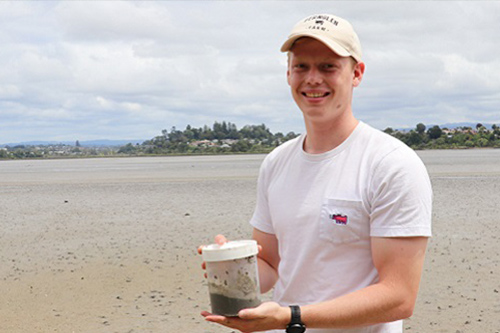Investigating the temperature tipping point of the marine biosphere
 Caleb Crosbie is driven to solve environmental problems through his research.
Caleb Crosbie is driven to solve environmental problems through his research.
Caleb Crosbie spent his summer research project knee-deep in Tauranga’s carbon rich tidal flats, and it whetted his appetite to do even more research for his master’s in the coastal environment.
Dr Terry Isson was Caleb's supervisor, and he was assisted in his research by Professor Louis Schipper, Dr Charlotte Alster, and master's graduate Allycia van der Laar.
Caleb investigated whether global change has had an impact on marine sediment communities, such as tidal flats. He also looked at samples along the Bay of Plenty coastline from Thames through to Whakatāne.
Tidal or mud flats are part of coastal foreshores covered and uncovered by the rise and fall of the tide. They are important ecosystems which provide habitat for many fish, bird and marine species.
Caleb looked at whether the increased temperature as well as nutrients in the surface layer would induce greater respiration rates and therefore greater nutrient cycling from both organic material and stored carbon sources.
“This is applicable to the study I did last year looking at nutrient loads in mangrove soils and short-term cycling of carbon,” says Caleb, who completed his Bachelor of Science in Environmental Sciences last year.
“With this year’s project, we found that all samples exhibited increased respiration rates at higher temperatures, giving evidence that more carbon dioxide will be leaving the system due to increased respiration than being absorbed by photosynthesis.”
It also suggests that an increased nutrient load in the surface water could lead to dissolution of carbon from the soil stores by increased microbial activity at lower temperatures, which means the mangroves and intertidal sediments could switch from acting as a carbon sink to a carbon source, says Caleb.
Tidal flats contain plenty of carbon dioxide stored in the form of organic material. Microbial communities break down the carbon created by primary producers like algae and seaweed and introduce it into the sediment.
The main part of his research project involved heating the sediment up, adding glucose and seeing whether the amount of CO2 released from the soil increased.
Caleb’s research has him now asking the question about when the global warming tipping point might occur. That would see more carbon dioxide released to the atmosphere rather than being removed.
The results have implications for our warming world, he says.
“Will marine sediments become more or less of a carbon dioxide sink in the future?”
Caleb’s research project was like other projects researchers had done on the land but was the first of its type in mud flats.
“We could see from the study quite a lot of similarities to what happens on land soils.”
Caleb was living in Singapore until starting at the University’s Tauranga campus in 2019.
“I’ve always loved the ocean and for me being able to work in the tidal flats doing this research is rewarding.”
He is conscious that as a scientist he is uncovering problems, so he wants to be part of the solution.
“This project has been a great opportunity to build on my research investigating the effect of warming temperatures and the effect on carbon stores within intertidal sediment.”
He wants to expand this research into a master research topic to cover a greater area of New Zealand coastline.